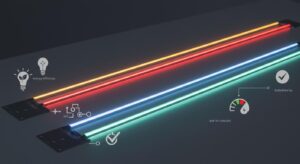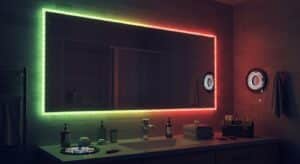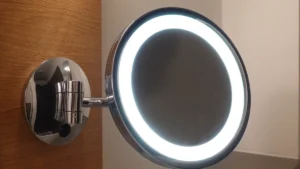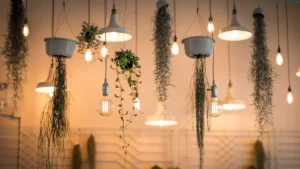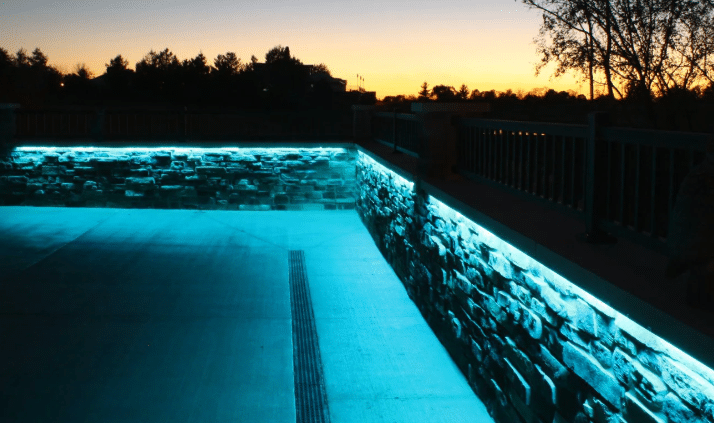
Outdoor lights contend with rain, dust, and harsh weather conditions. You need waterproof LED strips for outdoor use to ensure the lights function effectively. Strips such as IP68-rated and smart LEDs are exceptionally durable. Choosing the right ones saves both money and time in the long run. Whether illuminating a garden or decorating a patio, quality LED strips last longer and reduce your worries.
Key Takeaways
Pick waterproof LED strips with high IP ratings to block rain and dust.
Buy strong LED strips to save money; they last longer and use less power.
Use waterproof LED strips to light up gardens, patios, or pools beautifully.
Think about smart LED strips for easy brightness and colour control outdoors.
Clean and check connections often to keep your LED strips working for years.
Why Pick Waterproof LED Strips for Outdoor Lighting?
Benefits of Waterproof LED Strips
Protection from weather
Outdoor lights face tough weather all the time. Waterproof LED strips are made to handle rain, snow, and heat. They are strong and keep out dust and water. This makes them work well in any weather. Unlike regular lights, these strips last through bad conditions without breaking.
Here’s a simple table showing how durable different IP ratings are:
IP Rating | What It Protects Against | Strength Level |
|---|---|---|
IP20 | No water protection, blocks big objects | Low |
IP54 | Stops water drops at an angle | Medium |
IP65 | Handles splashes and short water dips | High |
IP67 | Fully dustproof, works in shallow water | Very High |
IP68 | Works in deep water for long times | Maximum |
Picking a higher IP rating keeps your lights working in tough weather.
Long-lasting and saves money
Waterproof LED strips are made to last a long time. They don’t wear out quickly, so you replace them less often. This saves you money over time. Plus, they use less energy than old-style lights. By choosing these strips, you save money and help the planet.
Where to Use Them
Garden and pathway lighting
Make your garden look magical with waterproof LED strips. Use them to light paths, show off flowers, or highlight special spots. You can change their brightness and colours to set the mood for walks or parties.
Patio and deck lighting
Good lighting makes your patio or deck cosy. Put waterproof LED strips on railings, under tables, or around edges. They create a warm glow for parties or quiet nights outside.
Poolside and water feature lighting
Waterproof LED strips are great for pools and fountains. IP68-rated strips can handle splashes or being underwater. Use them to light up waterfalls, fountains, or pool edges for a cool look.
Tip: Choose RGB LED strips for fun, colour-changing lights in your outdoor areas.
Top Picks for Durable Waterproof LED Strips

IP68-Rated LED Strips
Key features
IP68-rated LED strips are perfect for tough outdoor conditions. They block all dust and can stay underwater deeper than 1 metre. Their strong design helps them work well in harsh places, even underwater or in factories. High-quality materials improve their waterproof ability, making them great for long-term outdoor use.
Feature | Description |
|---|---|
Dustproof | Blocks all dust, keeping the strip clean. |
Water Immersion Capability | Works underwater deeper than 1 metre for long periods. |
Suitable Environments | Best for underwater, tough outdoor spots, and factory use. |
Pros and cons
Pros:
Very strong in bad weather.
Works well underwater or in deep areas.
Lasts long and uses less energy.
Cons:
Costs more than lower-rated strips.
May need a professional to install.
IP67-Rated LED Strips
Key features
IP67-rated LED strips protect well from dust and water. They can go underwater up to 1 metre for 30 minutes. This makes them good for wet places like gardens, pools, or fountains. They save energy and last long, making them a smart choice for outdoor lighting.
Pros and cons
Pros:
Keeps out all dust and resists water.
Great for wet or damp areas.
Cheaper than IP68-rated strips.
Cons:
Can’t stay underwater for long.
Not made for deep water use.
5050 SMD LED Strip Lights
Key features
5050 SMD LED strips are bright and flexible. They have bigger LED chips, giving strong light and bright colours. Waterproof versions are available, so they can be used outside. With RGB options, you can make colourful displays for your garden, patio, or pool.
Pros and cons
Pros:
Very bright with lots of colour choices.
Can be used in many outdoor places.
Cheap and simple to set up.
Cons:
Not as strong as IP67 or IP68 strips.
Waterproofing depends on the model.
Tip: Pick LED strips based on your needs like brightness, waterproof level, and how easy they are to install.
Smart Strip Lights with Waterproof Coating
Key features
Smart strip lights with waterproof coatings are strong and high-tech. They work well outside, even in bad weather like rain or snow. A silicone layer protects them from water and dust, making them last longer.
These lights come with different waterproof ratings like IP65, IP67, and IP68. IP65 lights can handle water sprays but not submersion. IP67 lights can go underwater briefly, up to 10 minutes. IP68 lights are fully waterproof and work underwater over 1 metre deep for a long time. This makes them great for patios, gardens, and pools.
You can customise smart strip lights easily. Change brightness, colours, and patterns using an app or voice commands. This helps you set the right mood for any event.
Pros and cons
Pros:
Strong and saves energy in many places.
Keeps working in dusty and wet conditions.
Simple to control with smart devices.
Looks great with adjustable colours and designs.
Cons:
Costs more than regular LED strips.
Needs steady Wi-Fi for smart features.
RGB LED Strip Lights for Outdoor Use
Key features
RGB LED strip lights are loved for their bright colours and flexibility. They mix red, green, and blue to make colourful displays. Waterproof versions are perfect for gardens, patios, and pool areas.
These lights are easy to put up, often with sticky backing to hold them in place. Many have remotes or apps to change colours and brightness quickly. They use little energy, so you get cool lighting without big electricity bills.
Pros and cons
Pros:
Offers many colours and fun lighting effects.
Waterproof types are good for outdoor spaces.
Cheap and easy to install.
Saves energy and lasts a long time.
Cons:
Not as tough as higher-rated waterproof LED strips.
Best for decoration, not heavy-duty use.
Tip: RGB LED strip lights are great for colourful and fun outdoor lighting.
Key Features to Think About
Waterproof Rating
What IP ratings mean
It’s important to know IP ratings for outdoor LED strips. These ratings show how well the lights block water and dust. For example, IP65 strips handle splashes, while IP68 ones work underwater. Higher ratings mean better protection. Always check the IP rating to match your outdoor needs.
Best IP ratings for outside
For outdoor use, IP67 and IP68 are the best choices. IP67 strips are great for damp spots like patios or gardens. IP68 strips are ideal for pools or fountains. If your lights face heavy rain or submersion, pick IP68 for top durability.
Strength and Build Quality
What they’re made of
The materials in LED strips decide how strong they are. Good-quality strips often have silicone or aluminium coatings. Silicone keeps out water and dust, while aluminium makes them tougher. Durable materials help the strips last longer in tough weather.
Tough against damage
Outdoor LED strips deal with bad weather and wear. Strong designs protect them from damage over time. Look for UV-resistant coatings and sturdy connectors. These features make the strips last longer and work better.
Brightness and Colour Choices
How bright they are
Brightness is key for outdoor lighting. Lumens measure how much light you see. Here’s a guide:
Path lights: 100-200 lumens.
Security lights: 300-700 lumens.
Garden lights: 50-300 lumens.
Here’s a table for quick reference:
Light Type | Lumen Range |
|---|---|
Wall Lights | 400 – 1200 lumens |
String Lights | 50 – 100 lumens |
Garden Lights | 50 – 300 lumens |
Knowing these ranges helps you pick the right brightness for your space.
Colour options: RGB or single
RGB LED strips give colourful, changing lights, perfect for fun decor. Single-colour strips provide steady light, good for paths or security. Choose RGB for a playful vibe or single-colour for focused lighting. Pick what suits your style and needs.
Power Source and Energy Efficiency
Battery-powered vs plug-in options
Pick the power source based on your needs. Plug-in LED lights are great for regular use. They connect to outlets, giving steady and bright light. These are best for patios or gardens needing constant lighting.
Battery-powered LED lights are easy to move around. You can use them anywhere without needing a plug. They’re perfect for parties or seasonal decorations. But, you’ll need to replace or recharge batteries often, which takes effort.
Both types save energy compared to old-style lights. LED strips use less power but still shine brightly. This lowers electricity costs and helps the environment.
Energy-saving features
Modern LED strips have smart ways to save energy. Dimmable lights let you lower brightness to use less power. Smart LED strips are even better. You can control them with apps to turn off when not needed. You can also set timers to use them only at certain times. These features save energy and make your lights last longer.
Ease of Installation
Adhesive backing and mounting options
Putting up outdoor LED strips is simple. Many have sticky backs, so you can stick them on walls, railings, or furniture. You don’t need tools or experts. For tricky spots, use clips or brackets to hold them in place.
Compatibility with smart home systems
Smart LED strips are easy to use and save energy. Many work with systems like Alexa or Google Home. You can control them with your voice or phone. Change colours or brightness without getting up. This makes outdoor lighting fun and convenient.
Tip: Choose smart LED strips with sticky backs and smart system support for the best experience.
How to Install and Maintain Outdoor LED Strips
Installation Tips
Getting the surface ready
Getting the surface ready helps your LED strips stick well. First, clean the area where you’ll place the strips. Use a damp cloth to wipe away dust, grease, or dirt. Let the surface dry fully before starting. A smooth, dry surface makes the adhesive work better, especially outdoors.
If you’re putting strips near water or tricky spots, ask a professional for help. Experts can follow safety rules and local laws. They can also plan how to mount the strips securely, considering the environment.
Fixing the strips in place
After cleaning, stick the LED strips using their adhesive backing. Press down firmly along the strip to make it stay. For uneven or hard-to-reach areas, use clips or brackets for extra support. In windy or wet places, these extra steps help the strips last longer.
Tip: Don’t pull or stretch the strips while installing. This can break the wires inside and shorten their life.
Maintenance Advice
Keeping them clean
Cleaning your LED strips often keeps them working well. Dust and dirt can build up outside over time. Wipe the strips gently with a soft cloth and mild cleaner. Check the IP rating first to make sure your cleaning method is safe for your strips.
Use | Best IP Rating |
|---|---|
Indoor spaces | IP20 |
Factories or warehouses | IP54 |
Outdoor areas | IP65 or IP66 |
Underground spaces | IP67 |
Underwater areas | IP68 |
Look at the wiring and connections regularly for damage. Use surge protectors to stop electrical problems. Choose strips with high IK ratings for better protection against impacts.
Protecting wires and power sources
Outdoor weather can harm wires and power parts. Use waterproof covers to keep water and dust out. Raise power sources off the ground to avoid water damage. Weatherproof covers for plugs and outlets add extra safety.
Fixing Common Problems
Lights flickering or dimming
Flickering or dim lights often mean voltage problems. Use a steady power supply to fix this. Make sure the power supply matches the strip’s energy needs. Adding a capacitor can also help balance the power.
Problem | What’s Wrong | How to Fix It |
|---|---|---|
Lights not turning on | Loose wires, bad power supply | Check wires, test the power source |
Flickering lights | Unsteady voltage, broken adapter | Use a stable power supply, check adapter |
Colours not matching | Faulty strip or controller | Check the strip and controller |
Note: Run your LED strips at low brightness to spot power issues. If flickering happens at full brightness, the power supply might not be strong enough.
Stopping water damage
Water can ruin LED strips and make them stop working. Pick strips with the right IP rating for your space. For example, IP68 strips are great underwater, while IP65 works for most outdoor areas. Seal all connections with waterproof tape or silicone to keep water out.
Tip: Check your strips often for water damage signs like fading colours or dim lights. Fix problems quickly to keep them working well.
Using strong waterproof LED strips improves your outdoor lighting. These lights are tough, save energy, and work in many ways. You can pick IP68-rated strips for underwater areas. Or, choose smart LED lights for settings you can change easily.
Here’s a simple table of their main benefits:
Benefit | What It Does |
|---|---|
Very Durable | Handles bad weather like rain, snow, and heat. |
Saves Energy | Uses less power, lowering your electricity costs. |
Long-Lasting | Works for over 50,000 hours, so fewer replacements are needed. |
Safe to Use | Gives steady light in all weather, reducing electrical dangers. |
Flexible Use | Suitable for patios, gardens, pools, and more. |
Bright and Adjustable | Offers strong, even light with options to change colours or brightness. |
Think about what you need, like colourful RGB lights for fun events. Or, pick strong IP68 strips for poolside lighting. Use this guide to choose wisely and enjoy reliable outdoor lighting for years.
FAQ
What is the best waterproof rating for outdoor LED strips?
IP68-rated LED strips give the best protection. They block dust and can stay underwater for a long time. Use IP68 strips for pools or fountains. For general outdoor areas, IP67-rated strips are a good option.
Can I install waterproof LED strips without professional help?
Yes, most LED strips are easy to install. They have sticky backs for simple placement. Clean the surface well before sticking them. For tricky setups near water, hire an expert for safety and better results.
How do I maintain outdoor LED strips?
Wipe them gently with a soft cloth to keep them clean. Check the wires and connections often for any damage. Use waterproof covers to protect wires and power parts from water. Good care helps your lights last longer and work better.
Are smart LED strips worth the investment?
Yes! Smart LED strips let you change colours and brightness easily. You can control them with apps or voice commands. They save energy and are very handy. If you want flexible lighting for events or daily use, they’re a smart choice.
Do waterproof LED strips consume a lot of energy?
No, LED strips use less energy than old-style lights. They give bright light while saving power. Many have dimmers and timers to use even less energy. This helps you save money over time.
See Also
Safe Ways to Install LED Strips for Outdoor Use
Ultimate Handbook for Using Outdoor LED Light Strips
Comparative Analysis of Bright LED Strips for Various Uses
